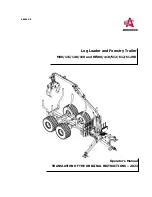
use common sense and good judgment when
performing this survey.
•
Slow down and use extra care on hillsides. Ground
conditions can affect the stability of the machine.
•
Avoid starting or stopping on a slope. If the
machine loses traction, proceed slowly, straight
down the slope.
•
Avoid turning on slopes. If you must turn, turn
slowly and keep the heavy end of the machine
uphill.
•
Keep all movements on slopes slow and gradual.
Do not make sudden changes in speed or
direction.
•
If you feel uneasy operating the machine on a
slope, do not do it.
•
Watch for holes, ruts, or bumps, as uneven terrain
could overturn the machine. Tall grass can hide
obstacles.
•
Use caution when operating on wet surfaces.
Reduced traction could cause sliding.
•
Do not operate the machine near drop-offs,
ditches, embankments, or bodies of water. The
machine could suddenly roll over if a wheel or
track goes over the edge or the edge caves in.
Maintain a safe distance between the machine
and any hazard.
•
Do not remove or add attachments on a slope.
•
Do not park the machine on a hillside or slope.
Starting the Engine
1.
Ensure that the battery-disconnect switch is in
the O
N
position.
2.
Ensure that the auxiliary-hydraulics lever and
traction-control are in the N
EUTRAL
position.
3.
Move the throttle lever midway between the
S
LOW
and F
AST
positions.
4.
Insert the key into the key switch and turn it to
the O
N
position.
5.
Wait for the glow-plug indicator light to stop
blinking.
6.
Turn the key to the S
TART
position. When the
engines starts, release the key.
Important:
Do not engage the starter for
more than 10 seconds at a time. If the engine
fails to start, wait 30 seconds for the starter
to cool down between attempts. Failure to
follow these instructions could burn out the
starter motor.
7.
Move the throttle lever to the F
AST
position.
Important:
Running the engine at high
speeds when the hydraulic system is cold
(i.e., when the air temperature is at or
below freezing) could damage the hydraulic
system. When starting the engine in cold
conditions, allow it to run in the middle
throttle position for 2 to 5 minutes before
moving the throttle to the F
AST
position.
Note:
If the outdoor temperature is below
freezing, store the traction unit in a garage to
keep it warmer and to aid in starting.
Driving the Machine
Use the traction control to move the machine. The
farther you move the traction control in any direction,
the faster the machine moves in that direction.
Release the traction control to stop the machine.
The throttle control regulates the engine speed as
measured in rpm (revolutions per minute). Place the
throttle lever in the F
AST
position for best performance.
You can, however, use the throttle position to operate
at slower speeds.
18
Summary of Contents for TX 1000 Compact Tool Carrier
Page 54: ...Schematics g240932 Electrical Schematic Rev B 54 ...
Page 55: ...g260360 Hydraulic Schematic Rev D 55 ...
Page 56: ...Notes ...
Page 57: ...Notes ...
Page 58: ...Notes ...





































